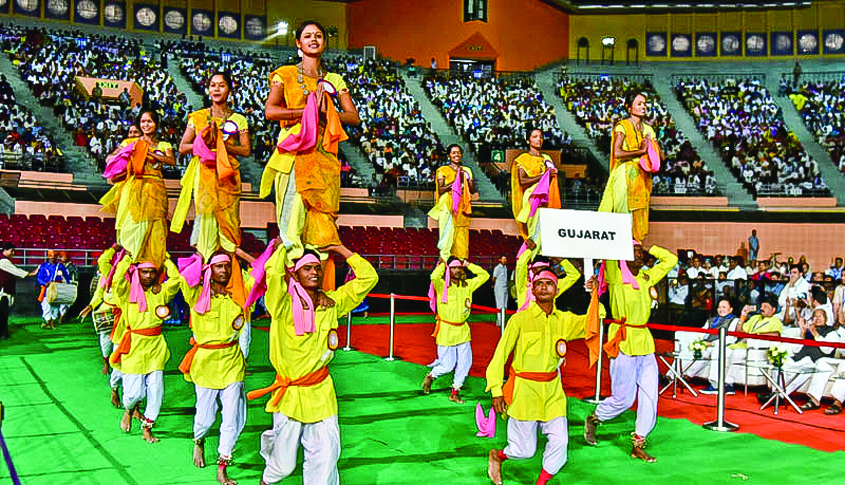The four-day event, which took place at Pragati Maidan, sought to present a vivid picture of India’s wide and diverse tribal culture. There were performances of tribal music and dance, exhibitions of tribal art, as well as workshops on issues concerning the many tribal communities of India. The event witnessed a participation of about 1,600 tribal artists and around 8,000 tribal delegates from across the country.
One of the biggest attractions was the tribal folk dances that were performed at the Hansdhwani amphitheatre by dance groups from across the country. Guardian20 interacted with many of the performing groups who were part of the event.
The Shivshakti group from West Bengal, which consisted of 40 members presented the traditional folk dances of the state which included the depiction of famous mythological tales like “Mahishasur Vadh”. The group was dressed in white attires with peacock feathers studded in their headdress. Subhas Mahato of the group told this correspondent that the original purpose of these dances was to propitiate the deities worshipped by the tribals of the state. The dancers perform regularly across the country.
The Rabha community of Assam was represented by a dance troupe of 15 members who performed the traditional Hamzar dance which is performed to seek the blessings of Goddess Mahalakshmi for a rich harvest. The members of the group hailed from Goalpara district in the state. This group has been in existence for a long time, more than 50 years according to one of their members, and now consists of junior artistes carrying forward the legacy.
There were two dance groups, representing two different communities, from the state of Madhya Pradesh. A 20-member troupe from the Gond community performed the Saila folk dance. Bala Singh Tekam, the leader of the group informed that Saila dance, unlike most other folk dances, is derived from the war excercises of the community. “This dance is usually performed during a 15-day festival which takes place around the time of Diwali and is also used for worshipping the community’s main deity which is believed to reside in the trees of forests,” says Tekam. The second group from Madhya Pradesh represented the Dhulia tribe which hails from the Anuppur district. Their dance is called “Gudum-baja” and it is customarily performed during weddings when the baraat arrives at the bride’s house. The group uses traditional instruments like a dhaphla made from goat skin and the gudum-baja from which the dance derives its name.
One of the biggest attractions was the tribal folk dances that were performed at the Hansdhwani amphitheatre by dance groups from across the country.
Jharkhand also had two communities representing it at the festival, the Ho tribe and the Santhal tribe. The group presenting the traditional Sarfa dance of the Santhal community was formed three years ago as part of Tata group’s CSR effort and is called Tribal Cultural Society. The dance troupe was made up of 11 women and four men. The dance takes its name from the instrument sarfa, which is used to provide music. This dance is performed by the members of this community during a festival called Sohrai which takes place after harvest and in which farm animals are decorated and celebrated for their contribution to farming and agriculture. Ho community’s traditional dance is performed on both the occasions of marriage and harvest. This dance involves two unique instruments called damad and dumang which are made from a special type of mud. The troupe was wearing green dresses as the colour green has special significance for the tribe.

Maharashtra’s delegation was from the Kokna tribe which lives in the Nasik region. The Birsa Munda group performed the Sambar and the Pawdi dances. Parmeshvaram Birari, a member of the group told Guardian20 that Sambar is performed at the time of marriage, whereas Pawdi is performed annually in a smaller form and once in five years in a larger form in order to propitiate the community’s deity called Dongargarh Devta to ensure prosperity, well-being and peace for all. On being asked why the group is named after Birsa Munda of Jharkhand, Birari explained, “Birsa Munda was a tribal, so he is a hero for tribals across the country.” Pawdi is a unique and complex instrument which is made using three different components: horns, a fruit called Bhopla and bamboo. Its music provides the unique tune for the dance.
There was also representation from the diverse Northeastern states of India. The Rongmei Naga community’s traditional folk dance called “Khoigu Na-Laam” (the Bee Dance) was performed by the group of Tribal Cultures Research Centre based in Manipur, founded by Johnson Phaomei. The Bee Dance seeks to imitate the actions of the bees as they fly to the hills to collect honey from the flowers. It includes vigorous foot work along with graceful movements of the body and is performed on various special occasions.
The attraction of the event was, as the event-name suggests, the display of India’s great tribal cultural diversity. The artists, apart from performing, also enjoyed watching fellow tribals from other parts of the state present their dance forms. Some of the performers interviewed by Guardian 20 said that they find the basic structure of all folk dances similar.
The colour and vibrancy of India’s tribal culture hasn’t been fully noticed by the rest of the country. Festivals like these would help them become more recognisable, and help initiate them into the mainstream.

